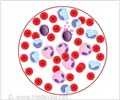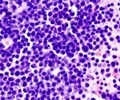- An overexpression of TRAF6 gene in the hematopoietic stem cells lead to poor production of blood cells finds a study from the Cincinnati Children’s Hospital.
- A new substrate of TRAF6 called hnRNPA1 is also an RNA binding protein.
- TRAF6 and its substrate could function as a potential target for drug therapy.
AML is an invasive and a fast-spreading blood cancer, which can be fatal if treatment is not initiated quickly.
Dr. Daniel Starczynowski, a cancer biologist, and his research team found that overexpression identified may increase production of a protein, TRAF6, in blood cells resulting in the development of myelodysplasia syndromes. This protein is known to function as a detector of pathogen entry and is vital in immune reactions.
Cincinnati Children's Hospital Medical Center’s Dr. Starczynowski who is a member of the Division of Experimental Hematology and Cancer Biology said that his research team found that an overexpression of the protein TRAF6 in the hematopoietic stem cells of mice leads to poor development of blood cells and a failure of the bone marrow to function well. The study conducted by the research team could be used for a number of therapeutic purposes with TRAF 6 as the target for drug therapy.
RNA Binding Protein
The studies were conducted on mouse models as well as on human models. While testing in mouse and human MDS and AML samples, the research team identified a new substrate of TRAF6 called hnRNPA1. This substrate is an RNA binding protein and was also found to be associated with Cdc42, which is a protein that aids in the regulation of blood cells and has also been identified in the development of certain forms of cancer.The advancements in molecular analysis, spearheaded by global proteomic analysis of disease cells allow identification of the entire protein system that leads to the development of a diseased state. In this study, new molecular biomarkers and targets for therapy were identified after global proteomic analysis of leukemia cells, which provided identification of the entire range of proteins that were regulated by TRAF6 in leukemia cells.
RNA Isoform Expression
The potential for the use of TRAF6 as a target for drug therapy was established in this study but it also revealed another critical aspect, the protein was also found to manage the expression of RNA isoform In response to various pathogens. This is a vital step in the translation process which involves the conversion of the genetic code into protein. Dr. Starczynkowski said that in the present study the RNA isoform expression that was regulated by TRAF6 is important in the development and function of blood cells and showcases another aspect of cellular behavior in response to infection.TRAF6 and cancer Progression
A previous study by Heng Sun et al titled “TRAF6 upregulates expression of HIF-1 and promotes tumor angiogenesis” showed that TNFR-associated factor TRAF6 played an important role in the activation of NF-κB, that was involved in the regulation of innate immune responses along with adaptive immune responses. TRAF6 interactions were important in the determination of receptor-associated cell death. TRAF6 has been implicated in cancer but its contributions have not been investigated deeply.It was found that TRAF6 increases expression of a factor called the hypoxia-inducible factor 1 (HIF-1). Though TRAF6 alters the levels of HIF-1 protein it has very little influence on the mRNA level. The results of the study show that TRAF6 increases HIF-1 expression and promotes tumor angiogenesis.
TRAF6 has been implicated in cancer disease progression. However, this is the first study that details the effect of the protein in the development of hematopoietic cells and also in the process of gene expression. The therapeutic targets that were identified can be used for drug therapy against Acute Myeloid Leukemia as well as for myelodysplasia syndrome, providing better care.
References:
- TRAF6 upregulates expression of HIF-1 and promotes tumor angiogenesis - (http://cancerres.aacrjournals.org/content/canres/early/2013/05/30/0008-5472.CAN-13-0370.full.pdf)















